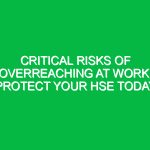Introduction
Events, whether large or small, can be a source of joy, networking, and learning. However, they also come with inherent risks that can jeopardize the health and Safety of participants, staff, and the Environment. Understanding these risks at an event is vital for effective planning and execution within the Health, Safety, and Environment (HSE) domain. The significance of managing these risks cannot be overstated, as they influence not only the immediate success of the event but also the long-term reputation of the organizing body.
In this article, we will explore various risks associated with events, the importance of robust HSE practices, and actionable insights to safeguard health and Safety. We will delve into potential Hazards, regulatory frameworks, and Best Practices to ensure a secure and successful event experience for everyone involved.
Understanding Risks at an Event
To effectively manage risks at an event, one must first understand what these risks entail. Risks can be categorized into several types, including physical, environmental, and health-related Hazards.
- Physical Risks: These involve accidents or injuries that may occur due to slips, trips, falls, or equipment failure. For example, a poorly marked stage can lead to falls, while inadequate crowd Control Measures can result in injuries during large gatherings.
- Environmental Risks: Events can have a significant impact on the surrounding environment. For instance, outdoor events may lead to soil erosion or pollution if not properly managed. Ensuring that waste is disposed of correctly and that the natural habitat is preserved is essential.
- Health Risks: These include the spread of communicable diseases, foodborne illnesses, and other health-related issues. A notable example is the COVID-19 pandemic, which brought health risks to the forefront of event planning.
Understanding these categories helps event organizers to assess and prioritize risks effectively.
Key Components of Risk Management in Events
Effective risk management involves several key components that should be integrated into the planning process. Identifying, assessing, and mitigating risks are crucial steps in ensuring a safe environment.
Risk Identification
The first step in managing risks at an event is identifying potential hazards. This can involve conducting a thorough risk assessment that considers all aspects of the event, including location, type of activities, and expected attendance.
For instance, an outdoor festival may face different risks compared to an indoor corporate meeting. Organizers should walk through the venue, assessing areas that may pose threats, such as uneven surfaces, electrical equipment, or insufficient exits. Engaging with experts in HSE can also provide valuable insights into potential risks that may not be immediately apparent.
Risk Assessment
Once risks are identified, the next step is to assess their likelihood and potential impact. This involves analyzing how likely a risk is to occur and the consequences it may have on attendees.
For example, a risk assessment might reveal that the likelihood of a severe weather event during an outdoor concert is moderate, but the impact could be catastrophic if attendees are not evacuated promptly. This assessment helps prioritize which risks need immediate attention and resources.
Risk Mitigation
After assessing risks, organizers must develop strategies to mitigate them. This can include implementing safety protocols, training staff, and ensuring that appropriate emergency services are on standby.
For instance, having clear signage, adequate lighting, and trained security personnel can significantly reduce physical risks. Additionally, establishing clear communication channels for emergencies ensures that all participants know what to do in case of an incident.
Real-Life Examples of Risks at Events
To illustrate the importance of effective risk management, let’s explore some real-life examples where the lack of attention to risks at an event led to significant issues.
The 2017 Manchester Arena Bombing
One of the most tragic incidents in recent history occurred during an Ariana Grande concert at the Manchester Arena. A suicide bomber detonated an explosive device, killing 22 people and injuring hundreds. This incident highlighted the need for robust security measures at large public events. In response, many event organizers have since increased security protocols, including bag checks, access control, and enhanced surveillance.
Woodstock 1999
The Woodstock 1999 music festival is another example where poor risk management led to chaos. The event was marred by violence, fires, and sexual assault allegations. The lack of adequate sanitation, high food prices, and extreme heat contributed to a volatile atmosphere. This case emphasizes the importance of planning for attendee welfare, including access to food, water, and emergency services.
Regulations and Standards Affecting Risks at Events
Various Regulations and standards govern health and safety at events, ensuring that organizers meet legal obligations and protect attendees. Understanding these regulations is essential for effective risk management.
Occupational Safety and Health Administration (OSHA)
In the United States, osha provides guidelines to ensure Workplace Safety, including events. Organizers must comply with OSHA standards to prevent workplace hazards, ensuring that staff and volunteers are trained to handle equipment safely and respond to emergencies.
Local Government Regulations
Local governments often have specific regulations regarding event permits, crowd management, and environmental impact. For example, obtaining a permit may require demonstrating how the event will ensure Public Safety and environmental Sustainability. Failing to adhere to these regulations can result in fines or event cancellations.
Best Practices for Managing Risks at Events
Implementing Best Practices in risk management can significantly enhance the safety and success of events. Here are some key practices to consider:
Develop a Comprehensive Safety Plan
A safety plan should outline all potential risks and the measures taken to mitigate them. This plan should be communicated to all staff and volunteers, ensuring everyone understands their roles in maintaining safety.
Regular Training and Drills
Conducting regular training sessions and emergency drills can prepare staff for various scenarios, from medical emergencies to severe weather conditions. This preparedness can help reduce panic and confusion during an actual incident.
Engage with Professionals
Consulting with HSE professionals can provide valuable insights into potential risks and effective mitigation strategies. They can assist in creating a tailored risk management plan that considers the specific nuances of your event.
Implement Feedback Mechanisms
After the event, gather feedback from attendees and staff regarding Safety Measures and potential risks encountered. This information can be invaluable for improving future events, ensuring that lessons learned are applied effectively.
Conclusion
In conclusion, understanding and managing risks at an event is crucial for ensuring the health and safety of all participants. By identifying potential hazards, assessing their impact, and implementing robust Safety Measures, event organizers can create a secure environment that promotes enjoyment and engagement.
The significance of adhering to regulations and employing best practices cannot be overstated. As we have seen through real-life examples, the consequences of neglecting these responsibilities can be severe. Therefore, it is imperative for event organizers to prioritize health, safety, and environmental sustainability in their planning processes.
As you prepare for your next event, take the time to assess the risks involved and develop a comprehensive plan to mitigate them. Your efforts can make all the difference in creating a safe and enjoyable experience for everyone involved.


